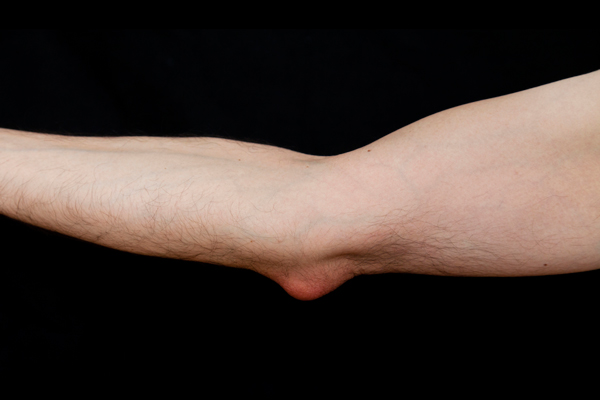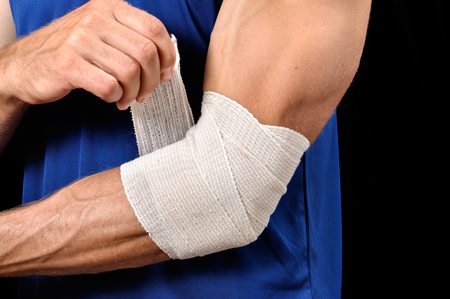Olecranon Bursitis
What is Olecranon Bursitis?
Bursae are fluid filled sacs that reduce friction allowing soft tissues (such as muscles, tendons, or skin) to glide past bony prominences. The Olecranon is the pointy bone at the base of the elbow. The Olecranon bursa is usually flat and lies between that bone and the loose skin. Inflammation can lead to excess fluid accumulation in the bursa resulting in bursitis.

What causes Olecranon Bursitis?
Trauma, infection, prolonged pressure, and certain medical conditions can all lead to Olecranon Bursitis. Any forceful contact of the elbow to a hard surface can lead to swelling of the bursa. Additionally, injuries such as scrapes, puncture wounds, and bug bites that break the skin can allow bacteria into the wound causing an infection of the bursa. As the infection progresses, the bursa will become inflamed producing extra fluid that may turn to pus without treatment.
Pressure from leaning on the elbows for extended periods of time may also irritate the bursa. Bursitis can be an occupational hazard for plumbers and other technicians that must crawl in tight spaces and lean on their elbows to complete a task. This type of Olecranon bursitis usually develops gradually over several months.
Inflammatory medical conditions like gout and rheumatoid arthritis are also frequently associated with Olecranon bursitis.

What are the symptoms of Olecranon Bursitis?
Typically, the first symptom noticed is edema since the elbow skin is usually rather loose. Pain results from the bursa being stretched as swelling progresses. The pain is often exacerbated by bending or placing direct pressure on the elbow. Eventually the inflammation may restrict the elbow’s range of motion.
In cases of Olecranon bursitis caused by infection, the skin will be warm and red. Without treatment the infection can spread and cause serious illness.

How is Olecranon Bursitis diagnosed?
The doctor will discuss symptoms and medical history. Physical examination will reveal demarcated swelling to the tip of the elbow. The bump may be warm, red, and tender to the touch. Pain may limit range of motion. Blood work may be ordered to determine if the bursitis is caused by infection, gout, rheumatoid arthritis, or another inflammatory condition. The physician may also use a needle to aspirate some of the bursa fluid to test for infection or gout. X-rays are taken to exclude fracture, bone spur or foreign bodies. Ultrasound and MRI may also be useful diagnostic tools.
How is Olecranon Bursitis treated?
Non-surgical
In Olecranon Bursitis caused by infection, fluid aspiration is not only used for diagnostic purposes, it can also relieve symptoms by reducing pressure inside the bursa. This fluid sample is tested to determine which antibiotic will be most effective for treatment. In this situation the physician will first prescribe a broad range antibiotic, followed by the specific antibiotic when the test results come in. This prevents the infection from progressing.
Conservative treatment of Non-infectious Olecranon Bursitis can also include activity changes, rest, elbow padding, and oral or injectable medications. Activities that put excess pressure on the elbows must be avoided or eliminated. Elbow pads can provide extra cushioning and protection to the area. NSAIDs (nonsteroidal anti-inflammatory drugs) may help reduce pain and inflammation. Occasionally, corticosteroid injections may be administered.

Surgical
If the elbow does not respond to conservative treatment, surgery may be indicated. If infection is present then the patient will have to spend the night in the hospital. If the bursa is not infected then the procedure can be done on an outpatient basis. In either situation, a small incision is made at the elbow, the inflamed bursa is removed, and the surgical wound is sutured closed. This wound heals in approximately 10 – 14 days with full recovery at about 3 – 4 months. Post-operatively the elbow is protected by a sling, splint or pad. Over time a healthy bursa will form where the inflamed bursa was removed.
Why see Dr. Knight for olecranon bursitis?
A patient shouldn’t hesitate to set up a consultation with Dr. John T. Knight if they suspect they might have olecranon bursitis. Dr. Knight is a board certified and fellowship trained orthopedic surgeon who has more than 25 years of experience in treating the hand, wrist and arm. He received his medical degree from the Louisiana State University School of Medicine, then successfully completed a Hand and Upper Extremity Fellowship at the Joseph H. Boyes Program in Los Angeles. To date, Dr. Knight has performed over 15,000 operations.
We looking forward to helping you live a more pain free life. Dr. Knight is one of the top hand doctors in Dallas. Visit Dr. John Knight at our Southlake hand and wrist center or Dallas office location.
Frequently Asked Questions:
Can olecranon bursitis go away on its own?
In most cases, yes, simple home care with icing and medication at home, and often the fluid may need to be drained, but further intervention is rare, or reserved for particularly serious cases. If you assiduously ice and rest the elbow with the bursa on it, there is no reason to assume it won’t resolve itself quickly. It may also help to wrap the elbow during healing, which will force the fluid from the bursa back into the joint cavity where it belongs.
Can I do my normal activities with olecranon bursitis?
In large part, bursitis is not going to stop you from engaging in most of the activities of daily life, including exercise. It is important to be very careful and discuss your needs with your doctor or therapist prior to engaging in any strenuous activity. If you are going to exercise, keep anything involving the elbow as light as possible, but other movements are fine. You don’t want to irritate the joint affected by the condition.
Does olecranon bursitis hurt?
When enough fluid enters the bursa to cause it to become inflamed, then it will likely become painful, which will indicate to you that you need to seek medical attention before it gets any worse.
Can olecranon bursitis be infected?
Infection is a very real concern with bursitis, and often when they become particularly painful, this is an indication of infection. This is known as septic bursitis, and is most common in people whose immune systems are suppressed as the result of other, usually unrelated conditions.
Surgical Video
Note: The following video contains graphic images.
Animated Videos
(817) 382-6789
Disclaimer
HandAndWristInstitute.com does not offer medical advice. The information presented here is offered for informational purposes only. Read Disclaimer

























